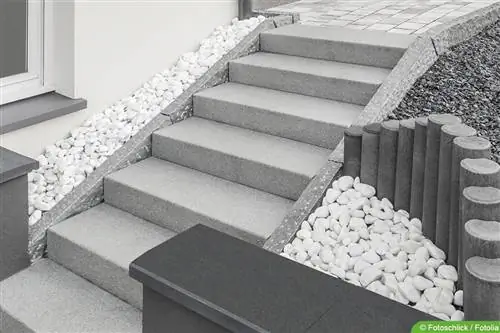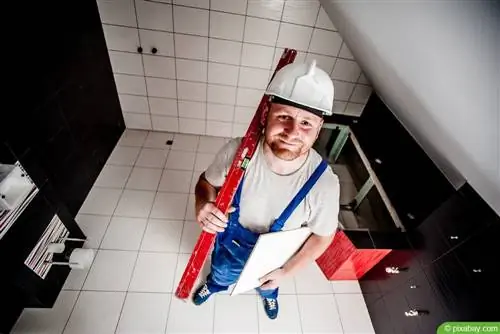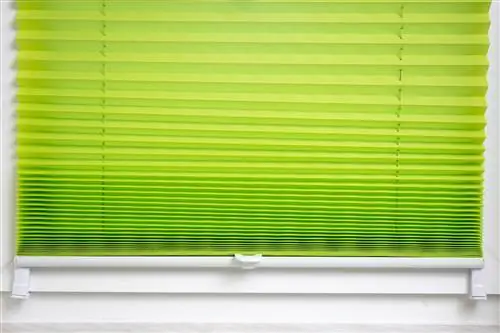- Author admin [email protected].
- Public 2023-12-17 03:39.
- Last modified 2025-01-24 12:45.
In order to be able to measure windows for a pleated blind, a few points must be taken into account, especially with unusual shapes.
Measuring instructions and calculation
There cannot be general instructions for measuring the pleats. The reason for this is the different distances between the fabric and the holder of the respective models. For this reason, manufacturers usually provide measuring instructions in their shop to help find the right model.
However, there are some factors that should be taken into account. For example:
- use suitable measuring devices
- measure several times
- Photograph special shapes of the window or draw to scale
- Get advice from the manufacturer
Tip:
If anything is unclear, you should always use the provider's contact options. This can avoid problems, returns and unnecessary effort. The measuring instructions from the shops are also helpful.
Rectangular windows
Rectangular or square windows are very easy to measure. Only the length and width need to be determined. In order to be able to choose the right pleated blind, you must first know the exact type of blind or assembly.
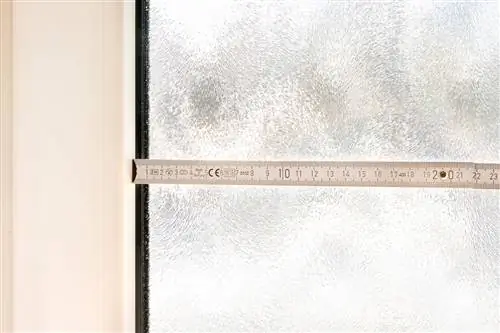
If these are attached to the ceiling above a window, the dimensions will of course be different than if they were attached directly to the window frame.
Note:
Usually a few millimeters have to be subtracted from the width of the window, but something has to be added to the length. However, the exact dimensions differ from manufacturer to manufacturer.
Pleas on the frame
If you want to attach pleated blinds without drilling, clamp pleated blinds are very popular. These are attached to the frame and are therefore easier to measure.
The height for this type of attachment is determined by simply measuring the height of the window frame. From the top edge to the bottom edge and here it can be a little more since the pleats are gathered.
When it comes to width, there are two values that need to be measured: minimum width and maximum width.
Minimum width
With the minimum width, the glass surface is covered by the window, it offers privacy but still allows some light to pass through on the sides. You measure inside the frame from one side (also called the glazing bead) to the other. Be sure to measure the rubber seal!
Maximum width
The maximum width is determined by the position of the window handle. If you exceed the maximum width, you will not be able to move the pleated blind properly without risking damage.

To measure, all you have to do is add the distance from the minimum width to the window handle twice. This means that the pleated blind has the same distance on both sides.
Pleated blinds in frame
In order to correctly measure the height and width of the pleated blind, the glass surface (be sure to include the rubber seal) must be measured here. So you measure from the inside of the window frame to the inside.
Tip:
Be sure to pay attention to the information provided by the manufacturer, as there are different types of pleated blinds and some models also need to take a little extra space into account. The depth of the glazing bead varies and therefore also determines the installation technique. You can find a configurator here.
Triangular windows
Measuring triangular windows is more of a challenge. However, these are particularly common in attics. The following measuring instructions offer help:
- Measure the width at the longest and narrowest points
- Measure the length of all sides
- Measuring or calculating angles
Note:
For special shapes and combinations of rectangles and triangles, it may be necessary to invest in a custom-made product. This also applies if, for example, the window in question is divided into different sections or only a partial area is to be darkened.
Round and oval windows
These special shapes represent a comparatively big challenge and may require custom-made products. For round windows, the diameter and circumference are usually sufficient information. An attachment can be made in the middle so that the narrower ends can be pulled up and down from there. An alternative is to choose a rectangular window cover and attach it directly to the wall.

This can significantly reduce costs and effort. It can also provide better coverage, which is a big advantage on the south side or on the ground floor in busy areas, for example. This also applies to oval windows. The longest and widest points are measured here.
Roof window
Roof windows can have unusual shapes and can also be embedded in sloping ceilings. Mounting on the ceiling or wall is therefore often difficult or even impossible.
Instead, the pleated blind often has to be fixed directly to the frame. This can be done by screwing or clamping. Gluing is also an option that is a useful alternative, especially in rented apartments and with slanted metal frames. When planning and measuring for the pleated blind, the following points should be taken into account:
- when measuring, note the distances between all corner points
- Determine where the pleat should be fixed
- Taking into account the shape of the window frame
- Factor in handle
The pleated blind should not pose any obstacle when opening and closing the window. Since roof windows can often only be tilted and the distances to sloping roofs can be very small, the handle must always be kept free. It may therefore be advisable to choose the dimensions of the pleated blind slightly smaller.
Tip:
With roof windows, it is often sufficient and more practical to only cover one section. This makes it useful to divide the window into different areas and therefore use different pleats.
Measure correctly
The quickest way to measure a window is with a tape measure. These are flexible and can therefore quickly measure into every corner.
To determine width x height, you can easily use a folding rule (also called folding rule, meter rule or bevel) with a trick. Here you will also need a pen and some painter's tape or a sticky note.
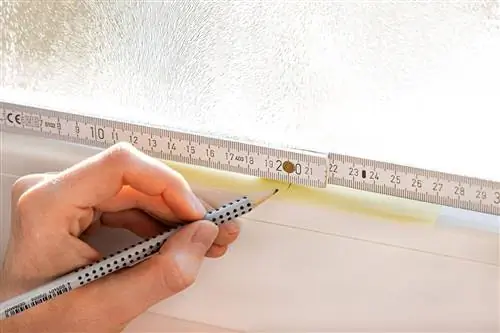
You place the ruler on one side and then use the post-it note and a pen to mark a round number on the window frame or on the pane. In the second step, measure exactly to the mark at the same point from the other side of the frame. Now all you have to do is add both measured numbers together and you have the exact measurement.
Tip:
It's better to check your measured numbers a second time and make sure that the numbers are correct.
For particularly high or wide areas, you should measure in at least three places (top/middle/bottom or left/middle/right) and then decide on the smallest value. This way you don't run the risk of the pleated blind hitting a spot later.
Avoid measurement errors
Please ask the manufacturer of your preferred pleated blind beforehand whether they recommend any special measures when measuring. There can also be significant differences due to different construction methods and types of fastening (assembly).
Take another close look at your window frame before measuring. There are different models here. Different depth of the glazing bead, is the glazing bead straight or slanted, the thickness of the window frame, the material of the window frame, etc. there are many things that need to be taken into account. For this reason, many pleated blind manufacturers also offer customer service, so take advantage of this.
Frequently asked questions
Are there alternatives to a pleated blind?
Yes, there are other options for blackout and privacy protection. These include, for example, blinds and curtains. Self-adhesive films can also be used to prevent unwanted views into the home.
Which type of assembly is best?
This depends on various factors. Above all, this includes the type of window frame and whether it is slanted, straight, made of wood or metal. Screwing is particularly durable. Clamping and gluing are also possible and are a good choice, especially for rental properties.
Are combinations possible?
A combination of pleats and curtains or foil can be a particularly practical solution both on the south side and in particularly exposed areas. This not only provides protection from the sun, but also provides insulation against heat and cold. The indoor climate can also benefit from this.


